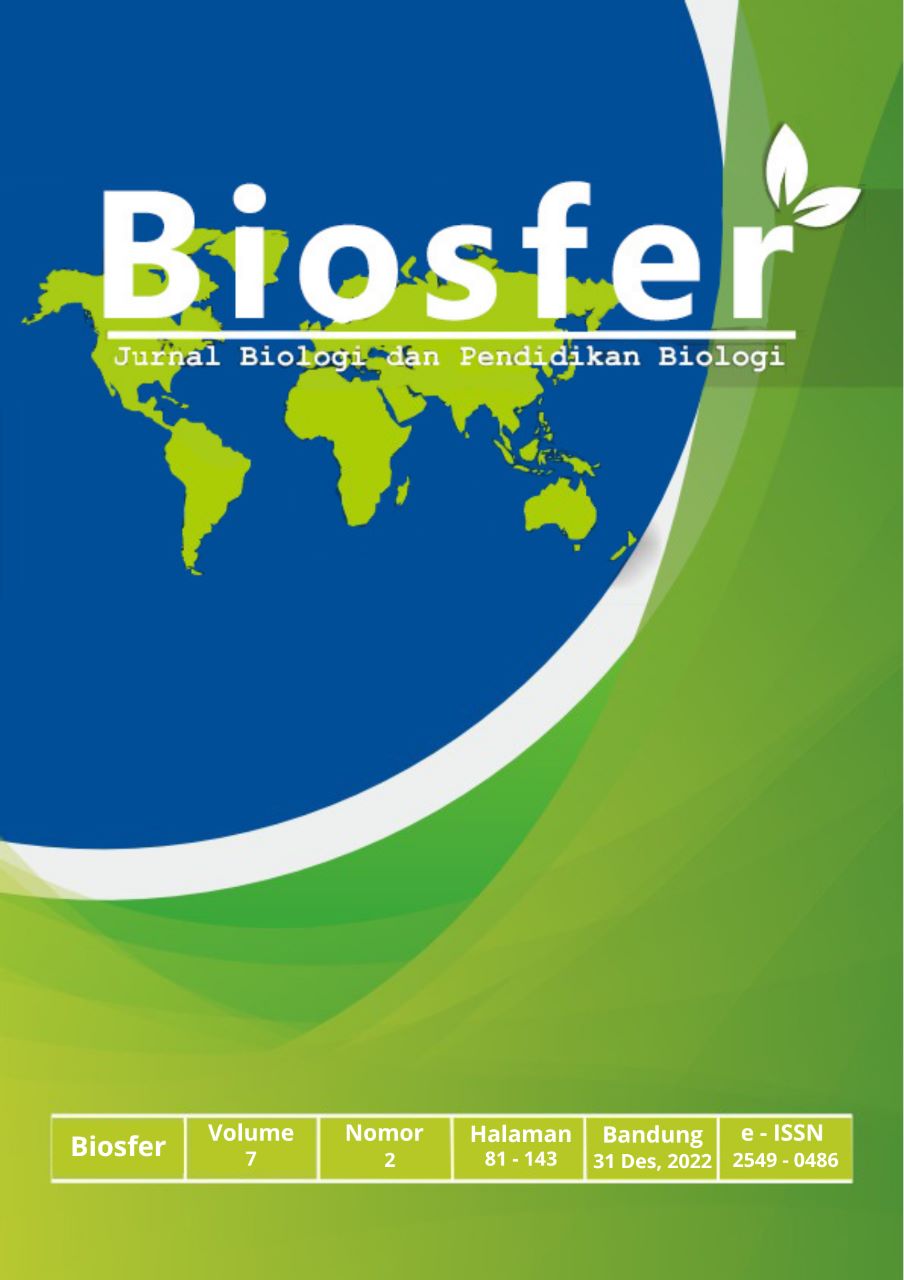Struktur dan Komposisi Tumbuhan Bawah di Zona Pegunungan Bawah Blok Malagembol, Cagar Alam Gunung Tilu, Jawa Barat
DOI:
https://doi.org/10.23969/biosfer.v7i2.6827Keywords:
Biodiversity, Mount Tilu, Tropical Forest, Understorey, VegetationAbstract
The understorey is one type of tropical forest vegetation that contributes to the complexity of the forest structure. The habitat of the understorey is closely related to the condition of the vegetation. This study aims to determine the structure and composition of the understorey to support the ecological function and habitat in the Malagembol Block, Mount Tilu Nature Reserve. The sample collection was carried out using the sample plot method. A total of three main plots measuring 10×100 m2 were divided into ten subplots with a size of 5×5 m2. The understorey observed included herbaceous plants and saplings with a height of less than 1 m. The data analysis included the calculation of frequency, density, individual dominance, and significant value index using heterogeneity index (Shannon-Wiener), richness index (Margalef), and evenness index. A total of 186 species and 66 understorey families were recorded in the observation plots. Based on their stature, they were grouped into 26 species of climbing plants, 43 species of herbaceous plants, and 116 species of saplings. The species richness was high and more diverse. In addition, the species found were evenly distributed in each observation plot and the plant community was relatively stable. The Mount Tilu Nature Reserve has an important contribution of understorey plants in compiling the ecosystem so that it becomes a further consideration for the management of the area around Mount Tilu Nature Reserve.
Downloads
References
Astuti, D. S., Supartono, T., & Adhya, I. (2019). Identifikasi Tumbuhan Bawah Dengan Pendekatan Kurva Spesies Di Blok Pasir Batang Karangsari Seksi Pengelolaan Taman Nasional Wilayah I Kuningan Taman Nasional Gunung Ciremai. Konservasi Untuk Kesejahteraan Masyarakat, 101–107.
Berliana, K. (2009). Pemetaan Kesesuaian Habitat Owa Jawa (Hylobates moloch Audebert, 1798) di Cagar Alam Gunung Tilu Kabupaten Bandung dengan Aplikasi Sistem Informasi Geografis. Bogor Agricultural University.
Cahyanto, T., Efendi, M., & Ramdan, D. M. (2020). Structure and composition of trees in mount Tilu nature reserve, West Java, Indonesia. Biodiversitas, 21(6), 2674–2680. https://doi.org/10.13057/biodiv/d210640
Cahyanto, T., Paujiah, E., & Yuliandiana, V. (2018). Anggrek Epifit Di Kawasan Konservasi Cagar Alam Gunung Tilu, Jawa Barat: Komposisi Spesies Dan Jenis Pohon Inangnya. Bioma : Jurnal Ilmiah Biologi, 7(1), 82–94. https://doi.org/10.26877/bioma.v7i1.2541
de Carvalho, A. L., d’Oliveira, M. V. N., Putz, F. E., & de Oliveira, L. C. (2017). Natural regeneration of trees in selectively logged forest in western Amazonia. Forest Ecology and Management, 392, 36–44. https://doi.org/10.1016/j.foreco.2017.02.049
Efendi, M., Lailaty, I. Q., Nudin, Rustandi, U., & Samsudin, A. D. (2016). Komposisi dan keanekaragaman flora di Gunung Pesagi, Sumatera. Prosiding Seminar Nasional Masyarakat Biodiversitas Indonesia, 2(2), 198–207. https://doi.org/10.13057/psnmbi/m020214
Gamito, S. (2010). Caution is needed when applying Margalef diversity index. Ecological Indicators, 10(2), 550–551. https://doi.org/10.1016/j.ecolind.2009.07.006
Gurnita, Prasasrti, A. R., Ibrahim, Y., & Mulyadi, A. (2022). Keragaman Jenis Tumbuhan Bawah Di Taman Buru Gunung Masigit Kareumbi, Cicalengka. BIOSFER : Jurnal Biologi Dan Pendidikan Biologi, 7(1), 50–57. https://doi.org/10.23969/biosfer.v7i1.5716
Helbach, J., Frey, J., Messier, C., Mörsdorf, M., & Scherer-Lorenzen, M. (2022). Light heterogeneity affects understory plant species richness in temperate forests supporting the heterogeneity–diversity hypothesis. Ecology and Evolution, 12(2), 1–14. https://doi.org/10.1002/ece3.8534
Hilwan, I., & Irfani, E. (2018). Pola Penyebaran dan Regenerasi Jenis Saninten (Castanopsis argentea Blume) di Resort Selabintana, Taman Nasional Gunung Gede Pangrango. Journal of Tropical Silviculture, 9(1), 53–59. https://doi.org/10.29244/j-siltrop.9.1.53-59
Junaedi, D. I., & Mutaqien, Z. (2010). Diversity of tree communities in Mount Patuha region, West Java. Biodiversitas: Journal of Biological Diversity, 11(2), 75–81. https://doi.org/10.13057/biodiv/d110205
Magurran, A. E. (1988). Diversity indices and species abundance models. Ecological Diversity and Its Measurement, 7–45. https://doi.org/10.1007/978-94-015-7358-0_2
Mehrotra, P., Kharakwl, G., & Pangety, Y. P. S. (2004). Ecological Implication of Plant Traits, Strategies and Competitive Abilities of Herbs. Applied Ecology and Environmental Research, 2(2), 1–13. https://doi.org/10.15666/aeer/03001013
Mokodompit, R., Kandowangko, N. Y., & Hamidun, M. S. (2022). Keanekaragaman Tumbuhan di Kampus Universitas Negeri Gorontalo Kecamatan Tilong Kabila Kabupaten Bone Bolango Rizaldi. BIOSFER : Jurnal Biologi Dan Pendidikan Biologi, 7(1), 75–80.
Montti, L., Campanello, P. I., Gatti, M. G., Blundo, C., Austin, A. T., Sala, O. E., & Goldstein, G. (2011). Understory bamboo flowering provides a very narrow light window of opportunity for canopy-tree recruitment in a neotropical forest of Misiones, Argentina. Forest Ecology and Management, 262(8), 1360–1369. https://doi.org/10.1016/j.foreco.2011.06.029
Mulya, H., Santosa, Y., & Hilwan, I. (2021). Comparison of four species diversity indices in mangrove community. Biodiversitas: Journal of Biological Diversity, 22(9), 3648–3655. https://doi.org/10.13057/biodiv/d220906
Mulyana, D., Kusmana, C., Budi, S. W., & Wasis, B. (2017). Species and Structure Compopsition of Nature Disturbed Forest Stand in International Journal of Sciences : Basic and Applied Research Species and Structure Compopsition of Nature Disturbed Forest Stand in Papandayan Mountain , West Java Indonesia. International Journal of Sciences: Basic and Applied Research (IJSBAR), 31(2), 286–296.
Mutaqien, Z., Kusmoro, J., & Santoso, P. (2008). Study Vegetasi Hutan Hujan Tropis Pegunungan di Gunung Manglayang Jawa Barat. Widyariset, 11(22), 157–164.
Norris, M., Wiryono, & Yansen. (2020). Analisis Keragaman Jenis Tumbuhan Bawah Pada Tiga Ketinggian Di Taman Wisata Alam Bukit Kaba Provinsi Bengkulu. NATURALIS-Jurnal Penelitian Pengelolaan Sumberdaya Alam Dan Lingkungan, 9(2), 51–57.
Su, X., Wang, M., Huang, Z., Fu, S., & Chen, H. Y. H. (2019). Forest understorey vegetation: Colonization and the availability and heterogeneity of resources. Forests, 10(11), 3–7. https://doi.org/10.3390/f10110944
Susilo, A. (2018). Asosiasi Jenis-jenis Pohon Dominan di Cagar Alam Gunung Tilu. Proceeding Biology Education Conference, 15(1), 813–819.
Tsvuura, Z., Griffiths, M. E., Gunton, R. M., Franks, P. J., & Lawes, M. J. (2010). Ecological filtering by a dominant herb selects for shade tolerance in the tree seedling community of coastal dune forest. Oecologia, 164(4), 861–870. https://doi.org/10.1007/s00442-010-1711-4
Türkmen, G., & Kazanci, N. (2010). Applications of various diversity indices to benthic macroinvertebrate assemblages in streams of a natural park in Turkey. Review of Hydrobiology, 3(2), 111–125.
Vongkamjan, S., & Sampson, F. B. (2016). Phenology, seed germination and some vegetative features of Strobilanthes fragrans (Acanthaceae), a recently described unusual species, found only in a single Forest Park in Thailand. Thai Forest Bulletin (Botany), 44(1), 6–10. https://doi.org/10.20531/TFB.2016.44.1.02
Willinghöfer, S., Cicuzza, D., & Kessler, M. (2012). Elevational diversity of terrestrial rainforest herbs: When the whole is less than the sum of its parts. Plant Ecology, 213(3), 407–418. https://doi.org/10.1007/s11258-011-9986-z
Downloads
Published
Versions
- 2022-12-31 (2)
- 2022-12-31 (1)
Issue
Section
License
Copyright (c) 2022 Biosfer : Jurnal Biologi dan Pendidikan Biologi

This work is licensed under a Creative Commons Attribution 4.0 International License.

























